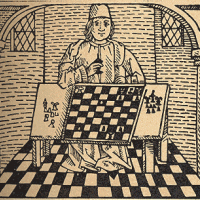
Who was Giuoco Piano?
Little is known of the reclusive 17th century Italian monk who lends his name to the opening that begins: 1. e4 e5 2. Nf3 Nc6 3. Bc4 Bc5 There are no academic histories available regarding Monsignor Piano, yet devoted scholar that I am, I was able to glean enough scraps of information from such far flung sources as Le Journal des Échecs d’Archéologie and Die Unbekannte Schachzeitung der Vatikanstadt to piece together the following general outline.
It is fairly certain that Giuoco Piano was an ardent student of that other famous monk, Ruy López de Segura, who lived a century earlier in Spain. Presumably, monks have little to do other than play chess when they are not busy gathering artistic masterpieces for the Vatican. I have been told that Pope Thelonius (formerly, Thelonius the Monk) suggested chess as an activity for clerics since it offers instruction in humility, not to mention humiliation.
In any case, Msgr. Piano, who was even quieter than most monks of the silent orders, loved to study the works of his Spanish predecessor. Yet legend has it that after one particularly discouraging defeat (see game below), the creative genius that was Piano rose up like a pissed-off but shining knight.
It was revealed to Piano in a vision that 3. Bc4 should replace the now-maligned 3. Bb5. “After all”, the patient Deity explained to a still-fuming Piano, “Bb5 had allowed Black to open the d-file [pronounced “dee file” in Italian - KG], which ultimately led to the Queen’s penetration.”
After showing this third-move innovation to his fellow monkmates and following some period of furtive debate behind the rectory, they all agreed, mainly for the hell of it, that the best reply for Black would be 3. Bc5 and history bears witness to their wisdom.
As a kind of literary footnote I should add that this event was the inspiration for James Surowiecki’s best-selling book The Wisdom of Crowds.
Piano went on to achieve many fine victories with this new opening, which also happened to bring glory to the Italians who really, really wanted an opening for themselves. I found one particularly instructive example of Piano’s resourcefulness with this opening while playing Greco in 1633. Although Greco conveniently left the game out of his notebooks, an unnamed onlooker who had just lost in Blitz to the trash-talking Greco, gleefully scratched the moves of his tormenter’s defeat onto a nearby paving stone which was discovered in 1943 when the Allies liberated Sicily.
An impressive display of attacking prowess that even Tal would envy.
Note to the gentle reader: This blog is one of a continuing series that discusses the players whose names grace many openings. Here are the links to these blogs published to date:
The Names behind the Openings, Part 1
http://blog.chess.com/kurtgodden/the-names-behind-the-openings-part-1
Bird to Bogo
http://blog.chess.com/kurtgodden/bird-to-bogo
Caro, Kann and Chigorin – Openings Players
http://blog.chess.com/kurtgodden/caro-kann-and-chigorin---openings-players
Evans and Göring: Gambiteers
http://blog.chess.com/kurtgodden/evans-and-gring-gambiteers
Who was Giuoco Piano?
http://blog.chess.com/kurtgodden/who-was-giuoco-piano

